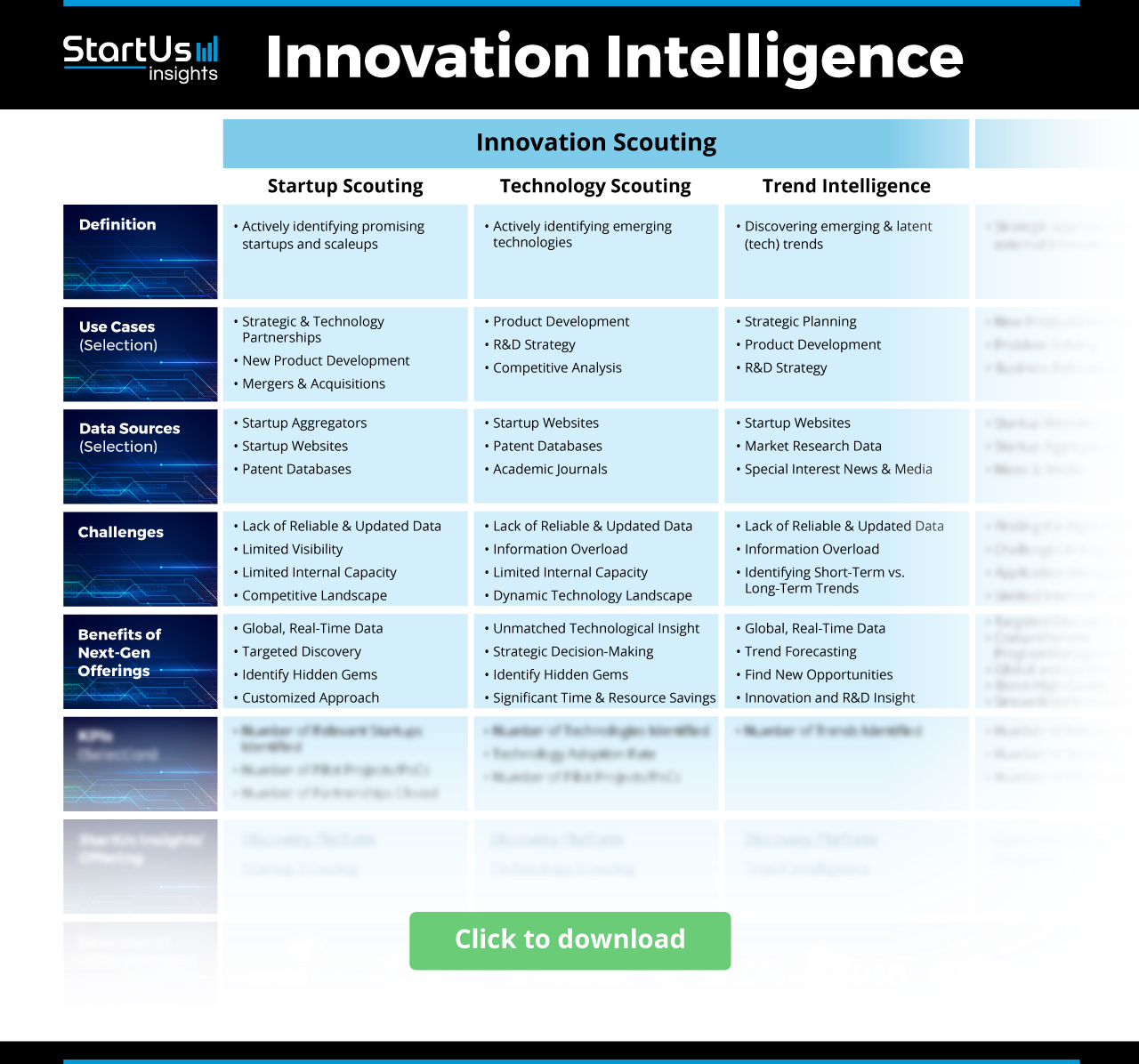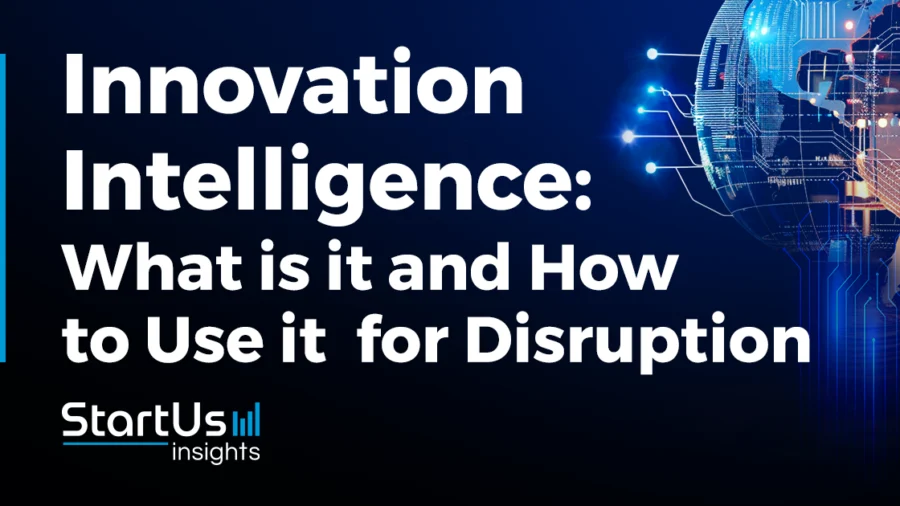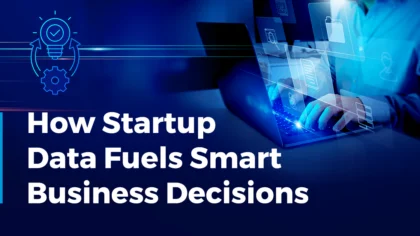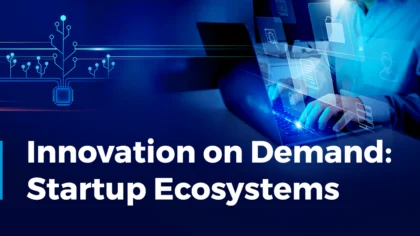The speed at which global innovators develop new technologies is simply mind-boggling. This is both a challenge and an opportunity for companies seeking to stay on top of their game.
Innovation intelligence can help companies continuously monitor the innovation landscape and better understand market demands. This allows companies to stay ahead of the curve and anticipate potential disruptions to their industry. By leveraging innovation intelligence, companies can thus turn the rapid pace of technological change into a competitive advantage.
Introduction to Innovation Intelligence
Innovation intelligence covers a range of approaches. These fulfill two main objectives: identify the most promising startups and technologies as well as emerging industry and market trends. This way, innovation intelligence delivers actionable insights on under-the-radar opportunities that advance your business needs. Major innovation intelligence methods include:

The landscape of innovation is evolving at a rapid pace. To keep up, companies are increasingly turning to data-driven approaches powered by big data and artificial intelligence (AI). The following article serves as a full guide to innovation intelligence, covering:
- Innovation Intelligence & its underlying methods
- Pain points of conventional innovation methods
- How new, data-driven approaches solve common challenges
- Real-world applications*
- How to empower and accelerate your own innovation goals with innovation intelligence
*While innovation intelligence is a proven practice for business growth, many case studies might be subject to non-disclosure agreements (NDAs). Therefore, specific business details, like company names, may remain confidential.
What Is Innovation Intelligence?
Data-driven innovation intelligence entails collecting, enriching, and analyzing largely publically available data on innovations worldwide. It provides you with a decision support system to execute your external innovation strategy effectively. The quality of translating data into intelligence depends on how exhaustive and precise the data is. Most innovation intelligence tools struggle to be exhaustive and precise since it is incredibly difficult to map the entirety of the world’s innovation in a manageable format.
The following methods present ways to strategically gather and leverage Innovation Intelligence to further your business goals.
Innovation Scouting
Innovation scouting is the proactive search for emerging trends, technologies, and their catalysts, such as startups and scaleups. This approach enables companies to foresee future scenarios and align their innovation goals with their industry’s direction. By doing so, organizations capitalize on new opportunities and drive their growth in alignment with evolving market demands.
The tools for innovation scouting or corporate scouting are divided into three key areas: startup scouting, technology scouting, and trend scouting or landscaping.
Startup & Technology Scouting Use Cases
- Product Development: Scout for new technologies or startups with innovative solutions to incorporate them into your product development efforts.
- Strategic Partnerships: Identify potential partners for collaborative projects such as proof of concepts (PoCs), to enhance your service offerings or address internal challenges.
- Ecosystem Engagement: Engage with the innovation ecosystem to stay on top of the latest startups, trends, and technologies.
- Dealflow & Acquisition Pipeline: Build a pipeline of innovative companies for potential investments and acquisition to boost your technology assets.
Trend Intelligence Use Cases
- Strategic Planning: Discover and track data-driven innovation to inform long-term strategic planning, ensuring alignment with future market directions.
- Market Forecasting: Scope and understand the developments of trends and narrow them down to a particular industry or a vertical, allowing you to anticipate market changes and consumer behaviors.
- Technology Adoption: Explore and act decisively on current and future trends in your industry and technology verticals. Compare trends and megatrends over time, geography, funding raised, and market size. Adapt and refine your company’s innovation strategy based on insights into prevailing and emerging trends & technologies.
- Risk Management: Understand trend developments and leverage new market opportunities before others. Identify potential disruptions or risks early on by monitoring trends, allowing for proactive measures.
Startup Scouting
Remember Blockbuster? In 2010, they had the chance to acquire Netflix for just $50 million, an opportunity they let slip through their fingers. Today, Netflix is a streaming giant while Blockbuster is a cautionary tale. This story highlights the ever-present threat of disruption and the critical need for companies to stay ahead of the curve.
This is where startup scouting comes in. It’s the strategic process of actively identifying promising startups and scaleups that precisely align with your business goals. Through startup discovery, you can uncover opportunities for collaboration, partnerships, or acquisition (“build, partner, buy strategy”), thus ensuring that your company remains a competitive force.
Common Struggles When Startup Scouting
- Limited Visibility: Traditional methods often miss the most innovative startups, especially those in niche markets or early stages.
- Resource Drain: Manual scouting involves significant time and effort. Evaluating countless startups requires dedicated resources, taking away from core business functions.
- Matching Needs: Finding startups with the right technology, market fit, and team for your specific needs can be like searching for a needle in a haystack.
- Competitive Landscape: Scouting becomes even more challenging when competing against other established corporations and venture capitalists targeting the same promising startups.
How Does Data-Driven Startup Scouting Compare?
- Find All Relevant Solutions: Be sure you don’t miss any opportunity by tapping into large startup and scale-up databases that reflect the global innovation ecosystem.
- Customized Approach: From identifying technical solutions for specific pain points to business development opportunities, data-driven and SaaS-based tools tailor startup scouting to your unique needs.
- Fast-Track Innovation: Gain access to cutting-edge technologies and products already under development, allowing you to leapfrog innovation stages.
- Stay Ahead of the Curve: By collaborating with emerging companies, you gain insights into the latest consumer trends and tech advancements, allowing you to adapt quickly to changing market dynamics.
Real-World Examples: Innovation Scouting in Action
- Retail Giant Embraces Sustainable Packaging: A major retail chain, struggling to meet its sustainability goals, used startup scouting to identify a young company developing eco-friendly packaging solutions. Through collaboration, they were able to implement this new technology and achieve significant progress towards their sustainability targets.
- Automaker Scouts for EV Battery Tech: A leading automaker facing disruption from EVs utilized startup scouting to find promising startups with cutting-edge battery technology. This led to a strategic investment, allowing the automaker to accelerate its own electric vehicle development and stay competitive.
Technology Scouting
Remember the dominance of Blackberry phones a decade ago? Today, smartphones with vastly superior technology rule the market and the once-giant smartphone manufacturer is nowhere to be seen.
BlackBerry’s decline serves as a reminder for businesses failing to adapt to technological advancements. Had they identified the rise of touchscreen technology and the shift towards app-driven functionality, they could’ve stayed relevant in the market.
Technology scouting is your best bet to win such races. It’s the systematic process of identifying and evaluating emerging technologies that precisely align with your organization’s innovation goals. Through technology mapping, you can uncover under-the-radar opportunities for partnerships or licensing.
Common Struggles When Technology Scouting
- Information Overload: The sheer volume of emerging technologies can be overwhelming. Identifying the truly impactful ones requires effective filtering and analysis.
- Limited Expertise: Evaluating the potential of complex new technologies may require expertise outside your core team’s capabilities.
- Hype vs. Reality: Not all emerging technologies live up to their initial promise. Discerning genuine breakthroughs from fleeting trends is crucial.
- Speed of Change: Technology moves fast. Maintaining a constant watch on the evolving landscape requires dedicated resources and ongoing vigilance.
How Do SaaS-based Startup Scouting Tools Compare?
- Future-Proof Your Strategy: Gain insights into disruptive technologies before they hit the mainstream. This allows you to adapt your business strategy and seize new opportunities before competitors.
- Identify Hidden Gems: Discover cutting-edge technologies still under development, potentially giving you a first-mover advantage in your industry.
- Unmatched Technological Insight: With in-depth analyses of emerging tech trends and their potential impact, novel tools ensure that you’re always on top of the frontier of innovation.
- Optimize Resource Allocation: By identifying technologies with the most potential, you can strategically allocate resources for R&D, ensuring maximum return on investment (ROI).
Real-World Examples: Innovation Scouting in Action
- Sustainable Aviation Fuel (SAF): A major airline used technology scouting to identify promising technologies for producing sustainable aviation fuels. This led them to invest in a startup developing a new biofuel technology, allowing them to reduce their carbon footprint and meet sustainability goals.
- Blockchain for Supply Chain Management: A leading retail company utilized technology scouting to discover the potential of blockchain for supply chain management. Through strategic partnerships, the company implemented a blockchain system that increased transparency, improved efficiency, and reduced costs.
Trend Intelligence
Imagine you predicted the rise of social media before it became a cultural phenomenon. Or that you anticipated the surge in online shopping before it transformed retail. This is the power of trend intelligence.
Trend intelligence (a.k.a trend landscaping or scouting) goes beyond simply noticing current trends. It involves deep analysis of a wide range of data to identify emerging and latent trends as well as developments that will impact your organization’s competitiveness in the long term. You can leverage insights from trend scouting to inform your business decisions, giving you an edge in today’s fast-paced market.
Common Struggles When Trend Scouting
- Data Overload: The sheer volume of innovation data available can be overwhelming, making it difficult to identify the most relevant and reliable sources.
- Interpreting the Data: Turning raw data into actionable insights requires expertise in data analysis and a deep understanding of your industry.
- Short-Term vs. Long-Term Trends: Distinguishing between fleeting fads and long-term trends with lasting impact is crucial for making informed business decisions.
- Change Happens Fast: Trends evolve rapidly. To stay ahead of the curve, continuous monitoring and analysis are essential.
How Does Data-Driven Trend Intelligence Compare?
- Uncover New Opportunities: Discover nascent trends that present new market opportunities or untapped customer segments, fueling your business growth.
- Make Informed Decisions: Base your strategic investments and product development on data-driven insights about future trends, minimizing risk and maximizing returns.
- Real-Time Data: Stay ahead of industry and market shifts with comprehensive, real-time trend analysis, allowing you to anticipate market changes with confidence.
- Innovation and R&D Insight: Utilize trend landscaping to refine your company’s innovation strategy, aligning R&D efforts with the latest and most promising technological advancements.
Real-World Examples: Trend Scouting in Action
- The Rise of On-Demand Services: A leading ride-hailing company identified the growing consumer preference for on-demand services through trend intelligence. This insight allowed them to expand beyond ride-hailing and offer other on-demand services like food delivery and grocery delivery, solidifying their position in the on-demand economy.
- The Shift to Sustainable Consumption: A major clothing retailer recognized the growing environmental consciousness among consumers through trend intelligence and launched a sustainable clothing line made from recycled materials. This proactive approach resonated with their target audience and boosted brand loyalty.

Open Innovation
Google released Android as an open-source platform, inviting developers around the world to contribute to its development. This collaborative approach allowed for the rapid development of a robust and versatile mobile OS. Today, Android powers billions of devices worldwide and is a testament to the power of open innovation.
Open innovation challenges the traditional model of isolated research and development to tap into the vast external innovation ecosystem. It’s a strategic business management model that encourages companies to seek collaborations with external partners, including startups and universities, to drive innovation. By leveraging the collective knowledge and expertise beyond your company walls, you can accelerate innovation and achieve breakthroughs quickly.
Open Innovation Use Cases
- Proof of Concept/Pilot: Test and evaluate new technologies or solutions through proof of concept or pilot projects to assess their feasibility and impact in a real-world setting.
- Soft Landing Program/Business Relocation: Facilitate business expansion into new markets or relocation by offering financial support, mentoring, resources, and access to networks and markets.
- Licensing: Acquire licenses for innovative technologies or products developed by others to quickly adopt and commercialize external innovations, enhancing product offerings.
- Investment Pipeline: Identify and invest in promising startups or technologies that align with strategic goals.
Common Struggles with Open Innovation
- Finding the Right Partners: Identifying and vetting potential partners with the right expertise and alignment with your innovation goals is crucial.
- Challenges in Engaging Startups: Startups generally lack active engagement with established companies’ programs. This can be due to a perception of complex application processes or unclear expectations.
- Limited Capacity: Companies do not have the necessary resources to execute open innovation programs.
- Identifying Niche Market Companies: Open innovation can be particularly challenging when seeking partners in highly specialized or niche markets. Traditional methods of scouting may not be effective, and established players may not be aware of all potential collaborators.
How Does Next-Gen Open Innovation Compare?
- Comprehensive Program Management: Handles the full scope of program setup, from creating landing pages to managing applications, providing a carefree solution for your innovation needs.
- Extensive Networks: Novel open innovation service providers have access to vast databases of startups, researchers, and potential collaborators, increasing the chances of finding the perfect partner.
- Streamlined Processes: These services provide dedicated teams and established processes for scouting, evaluating, and managing open innovation projects, saving your company valuable time and resources.
- Boost High-Quality Applications: With targeted direct outreach, service providers ensure that your startup call resonates with the right entrepreneurs, enhancing your visibility and reach within the global startup ecosystem.
Types of Open Innovation Services
Open innovation isn’t a one-size-fits-all approach. Here are some popular methods for harnessing the power of external collaboration:
- Innovation Challenges: Contests or competitions designed to spark creative solutions to specific problems.
- Ongoing Startup Programs: Startup programs designed for ongoing engagement with startups, offering an always-open platform for new ideas and engagement.
- Accelerator/Incubator-backed Programs: Organizations provide initial infrastructure and ongoing support, like an incubator, but with a curriculum and defined timeframe that pushes for faster output.
- Soft Landing Programs: Organizations support startups and scaleups to adapt their products and services to local market demands, regulations, and business practices.
Real-World Examples: Open Innovation in Action
- The Unilever Foundry: This program focuses on co-creation with startups and entrepreneurs across various industries, not just consumer products. For example, Unilever partnered with a startup to develop a new laundry detergent solution that uses less water and energy.
- Nestlé’s Open Innovation Platform: Nestlé leverages its open innovation platform to source ideas and collaborate with external partners on projects related to nutrition, health, and sustainability.
Business Intelligence
Companies turn to consumer and competitor analyses to improve their own performance. Business intelligence provides a wealth of data that informs and leads the strategic direction of organizations globally. This is why business intelligence is becoming a huge driver for innovation across industries.
Business Intelligence Use Cases
- Market Analysis: Analyze market trends, identify growth opportunities, and understand the dynamics of your market.
- Competitive Benchmarking: Monitor competitors’ activities, strategies, products, and performance. This includes analyzing competitors’ strengths and weaknesses, market share, and products to inform strategic planning and positioning.
- Digital Transformation: Stay ahead by monitoring emerging technologies, digital trends, and innovations that could impact your industry or vertical.
- Data-Driven Decision-Making: Inform strategic planning by getting insights into industry trends and technological advancements. This intelligence supports risk management and trend forecasting as well as guides long-term strategic decisions.
Organizations drive their strategic decisions primarily using three types of business analytics: market intelligence, customer intelligence, and competitor intelligence. While these approaches may sound similar, there is a clear difference. Here’s an analogy to solidify the difference: Imagine you’re a food company looking to innovate:
- Market Intelligence: You discover a growing trend towards healthier desserts.
- Customer Intelligence: You learn your customers are interested in low-sugar options but miss the taste of traditional treats.
- Competitor Intelligence: You see a competitor launching a line of sugar-free cookies that lack the desired texture.
Market Intelligence
Once a dominant force in the photography industry, Kodak failed to adapt to the rise of digital photography. Its focus on film technology, despite clear market signals pointing toward a digital future, ultimately led to Kodak’s downfall. This story exemplifies the importance of market intelligence in staying ahead of the curve.
Market intelligence companies offer you a complete understanding of your sector’s dynamics and its competitive environment. This competitive intelligence redefines your business strategy and operational effectiveness, making it an essential component for any business looking to compete and lead.
Common Struggles with Market Intelligence
- Data Overload: The sheer volume of data available, from social media to market research reports, can be overwhelming. Identifying the most relevant and reliable sources is crucial.
- Data Quality: Not all data is created equal. Ensuring the accuracy and reliability of the data you use is essential for making sound decisions.
- Interpreting the Data: Turning raw data into actionable insights requires expertise in data analysis and a deep understanding of your industry.
- Dynamic Market Landscape: Markets are constantly evolving and hence need continuous monitoring and analysis, requiring more time and resources.
How do Tech-driven Market Intelligence Tools Compare?
- Monitor Your Competitors: Gain insights into your competitors’ strategies, product offerings, and strengths and weaknesses. This allows you to develop a competitive advantage and differentiate yourself in the marketplace.
- Innovation and Growth: Identify emerging technologies and startups that could be potential partners or acquisition targets, fueling your innovation pipeline and supporting growth strategies.
- Significant Time & Resource Savings: Keep your endeavors on schedule, within budget, and perfectly aligned with your strategic objectives, all while maximizing resource efficiency and achieving desired results.
Real-World Examples: Market Intelligence in Action
- Identifying the Rise of Athleisure: A leading sportswear company used market intelligence to identify the growing popularity of athleisure wear. This insight allowed them to expand their product offerings beyond traditional athletic wear to include stylish and comfortable clothing for everyday wear.
- Understanding Evolving Customer Needs: A streaming service used market intelligence to understand its audience’s growing demand for diverse and high-quality content. This insight led them to invest in original programming and acquire exclusive rights to popular shows, attracting new subscribers.
Customer Intelligence
Remember the infamous “New Coke” debacle? In 1985, Coca-Cola drastically reformulated its signature drink based on market research that focused solely on taste preferences. However, they failed to consider consumers’ emotional connection with the original Coca-Cola recipe. The public backlash was swift and fierce, forcing Coca-Cola to revert to the original formula.
Coca-Cola’s case highlights the importance of customer intelligence. It shows how you need to go beyond basic demographics to understand your customer base’s deeper motivations, emotions, and behaviors.
Customer intelligence is the strategic process of collecting, analyzing, and interpreting data about your customers. This data encompasses everything from demographics and purchase history to online behavior and social media sentiment. By harnessing this wealth of information, you gain a 360-degree view of your customer, allowing you to build stronger relationships and predict customer behavior.
Common Struggles with Customer Intelligence
- Data Silos: Customer data often resides in different systems across your organization, making it difficult to gain a holistic view of each customer.
- Data Quality: Inaccurate or incomplete customer data can lead to misleading insights and hinder your ability to personalize the customer experience.
- Privacy Concerns: Balancing the need for customer data with respecting customer privacy is crucial. Transparency and clear communication are essential for building trust with your audience.
- Keeping Up with Change: Customer preferences and online behavior are constantly evolving. Continuously gathering and analyzing data is essential to maintain a current understanding of your customer base.
How do Tech-driven Customer Intelligence Tools Compare?
- Automated Data Collection: Leverages web scraping, social media listening APIs, and market research databases to gather vast amounts of data automatically.
- Advanced Analytics: Employs powerful algorithms and data visualization tools to uncover hidden trends, identify correlations, and generate actionable insights.
- Comprehensive Scope: Provides access to a wider range of data sources, including social media conversations, competitor websites, and consumer reviews.
- Real-Time Insights: Delivers real-time updates on market trends and competitor activity, enabling faster decision-making and adaptation.
Real-World Applications: Customer Intelligence in Action
- Product Innovation Inspired by Customer Feedback: A shoe manufacturer used customer feedback to identify a growing demand for comfortable yet stylish everyday sneakers. This insight led them to develop a new product line that addressed this unmet customer need and gained significant market share.
- Personalized Marketing Campaigns: A streaming service analyzed customer viewing habits and preferences to recommend content tailored to each user. This personalized approach significantly increased customer engagement and retention rates.
Competitor Intelligence
Competitor intelligence is the systematic process of gathering, analyzing, and interpreting information about your competitors. This knowledge empowers you to understand their strengths and weaknesses, anticipate their next moves, and ultimately gain a competitive edge in the marketplace.
Common Struggles with Competitor Intelligence
- Data Gathering: Relies on time-consuming manual research through competitor websites, press releases, and attending industry events.
- Limited Scope: Focuses on readily available information sources, potentially missing valuable insights hidden within competitor social media conversations, marketing campaigns, or job postings.
- Subjective Analysis: Relies on human interpretation of data, which can be prone to bias and may miss subtle trends or patterns.
- Time-Consuming: The entire process, from data collection to analysis, can be extremely labor-intensive, hindering responsiveness to competitor activity.
How do Tech-driven Competitor Intelligence Tools Compare?
- Identify Opportunities & Threats: Uncover your competitors’ vulnerabilities and weaknesses, allowing you to capitalize on gaps in their offerings. Similarly, identify potential threats posed by their strengths or new product launches.
- Benchmark Your Performance: Compare your company’s performance metrics against your competitors to identify areas for improvement and opportunities for differentiation.
- Predict Market Trends: By analyzing competitor behavior and product roadmaps, you can anticipate upcoming market shifts.
- Develop Winning Marketing Strategies: Gain insights into your competitors’ marketing tactics and messaging to develop targeted campaigns that resonate more effectively with your target audience.
Real-World Examples: Competitor Intelligence in Action
- Pioneering a Sustainable Solution: A manufacturer of household cleaning products used competitor intelligence to analyze the marketing strategies of leading cleaning brands. While many focused on germ-killing power and intense fragrances, the company noticed a growing trend towards eco-friendly cleaning solutions. This insight led them to develop a new line of plant-based cleaning products, capturing a significant market share.
- Anticipating a Competitor’s Move: A fast-food restaurant chain used competitor intelligence to learn about a rival’s plans to launch a new healthy menu line. This foresight allowed the company to pre-emptively introduce its own healthy menu options, maintaining its competitive edge.
Leveraging Innovation Intelligence: A Strategy for Business Growth
As outlined above, innovation intelligence emerges as a crucial tool for companies aiming to stay ahead. But how can you stay on top of the vast seas of data, startups, and emerging technologies to uncover opportunities that truly make a difference? This is where the concept of Big Data and AI-powered innovation intelligence becomes transformative, offering a structured approach to identifying and engaging with the innovations that could shape the future of your business.
We understand the challenge of filtering through noise to find signals that can lead to groundbreaking innovation. Our Discovery Platform and services are designed not to overwhelm but to enlighten, providing access to a curated database of over 4.7 million startups, scaleups, and 20K+ emerging technologies globally.
With StartUs Insights, you move beyond the conventional to embrace a future where innovation cycles are not just faster but more meaningful. Our suite of services, powered by the Discovery Platform, offers:
- Expert Guidance: Our team integrates with yours, offering specialized knowledge to fine-tune your innovation focus.
- Seamless Process: From trend spotting to partner identification, the platform ensures efficiency at every step.
- A Spectrum of Services: Tailored to meet diverse needs, our offerings range from Startup and Technology Scouting to Trends Landscaping and beyond.
Innovation intelligence can transform your approach to growth and strategic planning. With StartUs Insights, you have a partner equipped to guide you through this complex landscape, uncovering under-the-radar opportunities and streamlining your path to sustainable growth.
Ready to unlock the full potential of innovation intelligence for your business? Explore how our Discovery Platform and expert services can enhance your strategic decisions, driving growth and resilience in an ever-changing world!





![15 Top Market Intelligence Software Tools [2024] | StartUs Insights](https://www.startus-insights.com/wp-content/uploads/2024/03/Market-Intelligence-Software-SharedImg-StartUs-Insights-noresize-420x236.webp)
![13 Top Female-founded Startups Globally [2024] | StartUs Insights](https://www.startus-insights.com/wp-content/uploads/2024/03/Female-Founded-Startups-SharedImg-StartUs-Insights-noresize-420x236.webp)
